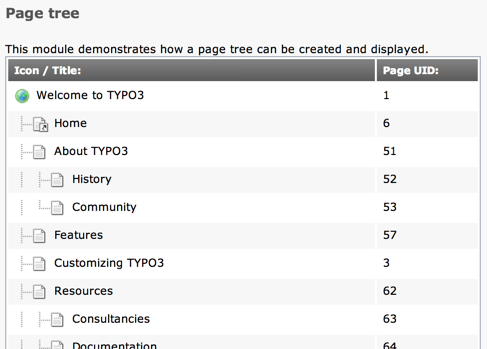Rendering Page Trees¶
In your backend modules you might like to show information or perform processing for a part of the page tree. There is a whole family of libraries in the core for making trees from records, static page trees or page trees that can be browsed (open/close nodes).
This simple example demonstrates how to produce the HTML for a static page tree. The result looks like:

A static page tree in TYPO3 Backend
The tree object itself is prepared this way (taken from
EXT:examples/Classes/Controller/DefaultController.php):
1 2 3 4 5 6 7 8 9 10 11 12 13 14 15 16 17 18 19 20 21 22 23 24 25 26 27 28 29 30 31 32 33 34 35 36 37 38 39 40 | public function treeAction() {
// Get page record for tree starting point
$startingPoint = 1;
$pageRecord = \TYPO3\CMS\Backend\Utility\BackendUtility::getRecord(
'pages',
$startingPoint
);
// Create and initialize the tree object
/** @var $tree \TYPO3\CMS\Backend\Tree\View\PageTreeView */
$tree = \TYPO3\CMS\Core\Utility\GeneralUtility::makeInstance(\TYPO3\CMS\Backend\Tree\View\PageTreeView::class);
$tree->init('AND ' . $GLOBALS['BE_USER']->getPagePermsClause(1));
// Creating the icon for the current page and add it to the tree
$html = \TYPO3\CMS\Backend\Utility\IconUtility::getSpriteIconForRecord(
'pages',
$pageRecord,
array(
'title' => $pageRecord['title']
)
);
$tree->tree[] = array(
'row' => $pageRecord,
'HTML' => $html
);
// Create the page tree, from the starting point, 2 levels deep
$depth = 2;
$tree->getTree(
$startingPoint,
$depth,
''
);
// Pass the tree to the view
$this->view->assign(
'tree',
$tree->tree
);
}
|
- At the top of the code we define the starting page and get the corresponding
page record using
\TYPO3\CMS\Backend\Utility\BackendUtility::getRecord(). - Next we create an instance of
\TYPO3\CMS\Backend\Tree\View\PageTreeView, which we use for generating the tree. Notice how the BE_USER object is called to get a SQL where clause that will ensure that only pages that are accessible for the user will be shown in the tree! - As a next step we manually add the starting page to the page tree.
This is not done automatically because it is not always a desirable
behavior. Note the use of
\TYPO3\CMS\Backend\Utility\IconUtility::getSpriteIconForRecord()to fetch the right icon for the page. - Finally we get the tree to prepare itself, up to a certain depth. Internally this will - in particular - generate a HTML part containing the tree elements and the page icon itself.
- The rendered page tree is stored in a data array inside of the tree object. We need to traverse the tree data to create the tree in HTML. This gives us the chance to organize the tree in a table for instance. It is this part that we pass on to the view.
The result is rendered with a very simple Fluid template:
<f:for each="{tree}" as="page">
<tr class="db_list_normal">
<td>{page.depthData -> f:format.raw()}<f:format.raw>{page.HTML}</f:format.raw> {page.row.title}</td>
<td>{page.row.uid}</td>
</tr>
</f:for>
We do a simple loop on the tree array of pages and display the relevant elements.
